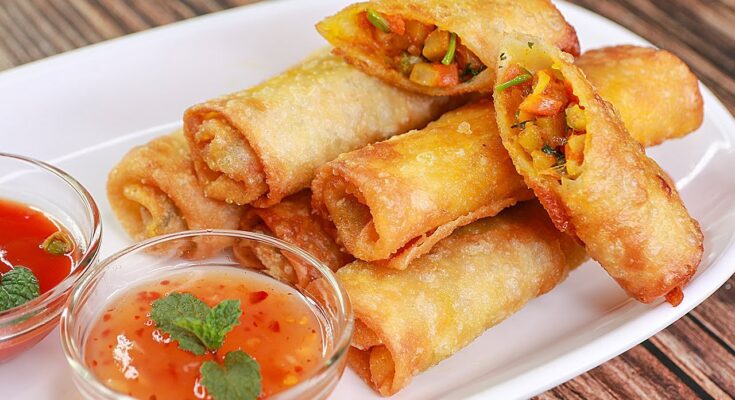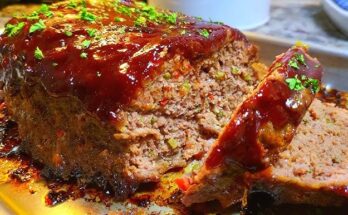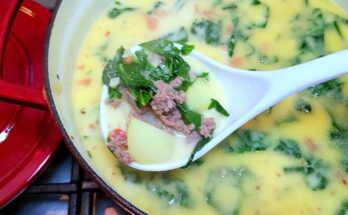Vegetable Spring Rolls Recipe: There’s something about a crispy, golden spring roll packed with fresh veggies that just hits differently. Whether you’re serving them as an appetizer, snack, or even a light dinner, vegetable spring rolls never disappoint. They’re crunchy on the outside, savory and flavorful inside, and pair perfectly with dipping sauces.
This guide will walk you through every single step—from selecting the freshest ingredients to wrapping and cooking the rolls like a pro.
Why Vegetable Spring Rolls Are a Global Favorite
Ever wondered why spring rolls are such a hit worldwide? These little bundles of joy originated in Asia but have become a beloved part of global cuisine for good reason. They’re delicious, versatile, and easy to adapt to various diets—vegetarian, vegan, gluten-free, you name it.
Spring rolls are loved for their crisp texture and vibrant, colorful fillings. Unlike many deep-fried snacks, they often feel lighter, especially when stuffed with fresh vegetables. Their popularity also comes from their adaptability—you can experiment with different fillings, wrappers, and dipping sauces. Whether it’s a backyard party, a potluck, or a quick midweek treat, spring rolls slide right into the scene and steal the show.
Ideal Occasions to Serve Vegetable Spring Rolls
So, when’s the best time to serve vegetable spring rolls? Honestly, anytime you want to impress. They’re a go-to for gatherings because you can prep them ahead and fry or bake them right before serving. They’re also a hit at:
- Game nights – crispy snacks always win!
- Lunchboxes – light yet satisfying.
- Appetizers for dinner parties – especially with a side of peanut or soy dip.
- Meal prep – make a batch and enjoy for days.
Plus, they’re portable, customizable, and just downright tasty.
Ingredients You’ll Need
Fresh Vegetables for the Filling
Your veggie choices are the heart of this dish. Go for freshness and crunch. Here’s a simple list of vegetables that work perfectly for spring rolls:
- Cabbage (green or purple) – thinly shredded for volume and crunch.
- Carrots – julienned for sweetness and color.
- Bell peppers – red, yellow, or green for vibrant taste and look.
- Bean sprouts – add lightness and texture.
- Green onions – for a mild, oniony kick.
- Garlic & ginger – finely minced for aromatic depth.
Want to elevate the flavors? Toss in mushrooms, zucchini, or even some tofu. Just make sure to julienne or finely slice everything to help the rolling process.
Wrapper Options: Rice Paper vs. Spring Roll Sheets
There are two main wrapper styles for vegetable spring rolls, and each gives a different vibe:
- Rice Paper Wrappers (for fresh rolls): These are soft, slightly chewy, and typically served raw or chilled. You just need to dip them in warm water to soften.
- Spring Roll Pastry Sheets (for crispy rolls): These are made from wheat flour and give that golden, crunchy finish when fried or baked. Found in the frozen section of most grocery stores.
For this guide, we’ll focus more on the crispy fried spring roll version, which is the classic, crowd-favorite.
Seasonings and Sauces
The seasoning is what brings life to the veggie mix. You don’t want bland spring rolls. So, here’s what you’ll need:
- Soy sauce – adds a salty umami base.
- Sesame oil – for that deep, nutty aroma.
- Salt and pepper – to taste.
- Cornstarch slurry (1 tsp cornstarch + 1 tbsp water) – optional, helps bind the filling slightly.
Other great add-ins:
- Chili flakes or sriracha – if you like a bit of heat.
- Hoisin sauce – for a sweet-savory depth.
Optional Add-Ins and Substitutes
Spring rolls are like blank canvases—there’s so much room for creativity.
Here are some bonus ingredients you can swap or add:
- Glass noodles (vermicelli) – add chewy texture.
- Tofu crumbles or tempeh – for extra protein.
- Avocado slices – in fresh rolls.
- Spinach or kale – for more greens.
- Lettuce leaves – acts as a filler and keeps things light.
Avoid too-wet ingredients, though—too much moisture can make the rolls soggy or fall apart when cooking.
Tools and Equipment Needed
Basic Kitchen Tools
You don’t need anything fancy, but having the right tools will make your spring roll adventure much smoother.
Here’s what you’ll want on hand:
- Chopping board and knife – for slicing veggies fine and thin.
- Large skillet or wok – to stir-fry the filling.
- Mixing bowls – to combine and season ingredients.
- Rolling surface (clean table or cutting board) – for assembly.
- Brush or your fingers – to seal the wrapper edges.
- Tongs – for flipping while frying.
- Slotted spoon or wire rack – to drain excess oil after frying.
- Paper towels – to blot the fried rolls.
Tips for Preparing Your Workspace
Before you start rolling, prep your space. Trust me, it makes everything easier.
- Have all ingredients prepped and ready – mise en place is key.
- Create a “rolling station”: Place the wrappers, filling bowl, and a damp cloth nearby.
- Keep wrappers covered – if using spring roll pastry, cover with a damp towel to prevent drying.
- Use a damp towel or water dish – to help seal the rolls easily.
Once everything’s laid out and you’re in your groove, rolling becomes an oddly satisfying process.
Step-by-Step Guide to Making Vegetable Spring Rolls
Step 1: Prepare the Vegetables
Julienne cabbage, carrots, bell peppers, and bean sprouts into thin strips. Keep them evenly sized for consistent cooking and easy rolling.
Step 2: Sautéing or Stir-Frying the Filling
Heat 1 tablespoon of oil in a wok or skillet. Add the vegetables and stir-fry for 2–3 minutes with soy sauce, salt, and a dash of sesame oil until slightly tender but still crisp. Let cool.
Step 3: Setting Up Your Rolling Station
Place spring roll wrappers, a bowl of water or flour paste for sealing, and the cooled filling within easy reach.
Step 4: Rolling the Perfect Spring Roll
Lay a wrapper diagonally, add a spoonful of filling, fold in the sides, and roll tightly—sealing the edge with water or paste.
Step 5: Frying, Baking, or Air-Frying Your Rolls
- Fry: Cook in 350°F (175°C) oil until golden brown.
- Bake: Bake at 400°F (200°C) for 15–20 minutes.
- Air-fry: Air-fry at 375°F (190°C) for 10–12 minutes.
Serve hot with sweet chili or soy dipping sauce—crispy, fresh, and delicious!
Dipping Sauces for Spring Rolls
Classic Soy-Garlic Sauce
This is your go-to if you want bold, salty, umami-packed flavor. It’s quick, easy, and complements vegetable rolls beautifully.
Ingredients:
- 2 tbsp soy sauce
- 1 tsp rice vinegar
- 1 minced garlic clove
- 1/2 tsp sugar
- A dash of sesame oil
Mix everything in a small bowl, and you’re good to go!
Sweet Chili Sauce
If you’re into that sweet-meets-spicy vibe, this one’s for you.
Ingredients:
- 3 tbsp sweet chili sauce (store-bought is fine)
- 1 tsp lime juice
- Optional: chopped cilantro or green onions
It’s great for kids and those who can’t handle too much heat but still want a flavor punch.
Peanut Dipping Sauce
This rich, creamy sauce adds a nutty twist that pairs perfectly with crunchy rolls.
Ingredients:
- 2 tbsp peanut butter
- 1 tbsp soy sauce
- 1 tsp honey or maple syrup
- 1 tbsp warm water
- 1/2 tsp chili sauce (optional)
Whisk until smooth and adjust thickness with more water if needed.
How to Make It Gluten-Free or Vegan-Friendly
Choosing the Right Wrappers and Sauces
If you’re catering to special diets—vegan, vegetarian, or gluten-free—don’t worry. Vegetable spring rolls are incredibly easy to adapt without sacrificing taste or texture. Let’s start with the wrappers.
For gluten-free diets, make sure to:
- Use rice paper wrappers or gluten-free certified spring roll wrappers.
- Double-check packaging labels for any hidden gluten or wheat-based binders.
For vegan diets, stick with:
- Standard vegetable fillings (skip any sauces that contain fish sauce or oyster sauce).
- Use vegan-certified wrappers, as some store-bought brands may contain egg or milk derivatives.
When it comes to sauces, it’s crucial to read the labels. Soy sauce, for instance, usually contains wheat, so opt for tamari as a gluten-free alternative. Similarly, avoid dipping sauces made with honey if you’re preparing strictly vegan versions—swap it with maple syrup or agave.
Avoiding Hidden Gluten or Animal Products
You might be surprised where gluten and animal-based ingredients can sneak in. Here are some hidden sources to avoid:
- Hoisin sauce – often contains wheat and sometimes anchovy extract.
- Worcestershire sauce – traditionally contains anchovies.
- Spring roll pastry – some frozen brands include egg; always check the ingredients list.
- Processed tofu or mock meats – double-check for gluten-based binders.
Always scan for labels like:
- “Certified Vegan”
- “Gluten-Free”
- “Plant-Based”
Or better yet, make your sauces from scratch (like we did above). That way, you control every ingredient going into your food.
Pro tip: If serving guests with dietary restrictions, keep a separate set of rolls and clearly label them. It’s a thoughtful touch that everyone will appreciate.
Common Mistakes to Avoid
Overstuffing the Rolls
It’s tempting, right? You’ve got all these delicious veggies, and you just want to pack in as much as possible. But here’s the deal—overstuffing is the #1 mistake when making spring rolls.
Why?
- The wrapper might tear during rolling or cooking.
- The roll could burst open when fried or baked.
- It becomes hard to get that tight, neat cylinder shape.
- Too much moisture from overfilling can lead to sogginess.
Stick to about 2 tablespoons of filling for a standard-sized wrapper. The goal is a tight, firm roll—not a bursting pocket.
Also, let your cooked filling cool down before wrapping. Hot fillings release steam, which softens and weakens the wrapper, making it prone to tearing.
Using Wet Wrappers or Overfrying
Another common pitfall? Letting your wrappers get too wet or soggy before rolling. If you’re using rice paper, only dip them briefly in warm water—just enough to soften them. Oversoaking leads to a slippery mess that’s almost impossible to handle.
And when it comes to cooking, many home cooks make the mistake of:
- Overheating the oil – this can burn the outside before the inside is even warm.
- Undercooking – leading to a soggy, chewy texture.
- Frying too many at once – which drops oil temperature and makes the rolls greasy.
Stick to small batches and keep your oil at 350°F (175°C) for best results. And remember—golden brown is your friend. Anything darker usually means bitter taste.
Storage and Reheating Tips
Best Practices for Storing Uncooked and Cooked Rolls
You made a batch, but you can’t eat them all at once? (Though honestly, it’s hard to resist.) Here’s how to keep them fresh:
Uncooked Rolls:
- Place them in a single layer on a tray lined with parchment paper.
- Cover with plastic wrap or a damp towel.
- Store in the fridge for up to 24 hours.
- Avoid stacking them—they might stick together.
Cooked Rolls:
- Let them cool completely first (don’t trap steam).
- Store in an airtight container, with paper towels between layers.
- Refrigerate for up to 3 days.
How to Reheat Without Making Them Soggy
Cold spring rolls are… meh. Here’s how to reheat and bring back that crispy magic:
Oven:
- Preheat to 375°F (190°C).
- Bake for 8–10 minutes, flipping halfway.
Air Fryer:
- Set to 350°F (175°C).
- Air fry for 5–7 minutes.
Avoid microwaving unless you want chewy, sad spring rolls. If you must use a microwave, wrap them in paper towels and use short bursts.
Bonus Tip: You can freeze uncooked spring rolls for up to a month. Place parchment paper between them and store in a zip-top bag. When ready to eat, fry them straight from frozen—just add a few extra minutes to the cooking time.
Serving Suggestions and Pairings
What to Serve with Spring Rolls
These rolls are stars on their own, but pairing them with the right side dishes turns them into a full meal. Here are some delicious ideas:
- Steamed jasmine rice or fried rice
- Chow mein noodles
- Asian-style coleslaw
- Miso soup or clear veggie broth
- Edamame or steamed dumplings
Spring rolls also make a fantastic starter for a larger Asian-inspired feast.
Want to add some freshness? Serve with lettuce leaves, mint, and Thai basil on the side. Let guests wrap their spring rolls in greens for a fun, interactive experience.
Beverage Pairings for Spring Rolls
You might not think much about drinks with spring rolls, but the right sip can elevate the whole experience.
Try these pairings:
- Green tea – classic, light, and refreshing.
- Sparkling water with lime – keeps the palate clean.
- Cold lager or Asian beer – crisp beer + crunchy rolls = magic.
- Citrus-infused mocktails – balances the savory flavors.
- Dry white wine – think Sauvignon Blanc or Pinot Grigio.
No matter what you pair them with, the key is keeping the drink light and not overly sweet. Let the rolls shine!
Nutritional Information
Calories and Macronutrient Breakdown
Vegetable spring rolls are surprisingly balanced, especially when baked or air-fried. Here’s an approximate breakdown per roll (fried):
| Nutrient | Amount (Approx.) |
|---|---|
| Calories | 120–150 kcal |
| Carbs | 18g |
| Protein | 3–5g |
| Fat | 5–7g |
| Fiber | 2g |
| Sugar | 1–2g |
These numbers vary depending on your filling and cooking method. For a lower-calorie version, bake or air fry and use less oil.
Making It a Healthy Snack Option
Want to make spring rolls even healthier? Here’s how:
- Use whole-wheat wrappers or rice paper.
- Add more greens like spinach or kale.
- Limit sodium in sauces; go for low-sodium soy or tamari.
- Bake or air fry instead of deep-frying.
- Add plant-based protein like tofu or edamame.
You can also serve them with a side of fresh fruit or salad for a complete, fiber-rich meal.
FAQs about Vegetable Spring Rolls Recipe
1. Can I make vegetable spring rolls ahead of time?
Absolutely. Prepare and roll them, then store them uncooked in the fridge for up to 24 hours. Fry or bake just before serving for the best crunch.
2. Are vegetable spring rolls served hot or cold?
Traditionally, fried spring rolls are served hot, while fresh (rice paper) rolls are served cold or at room temperature. It depends on the type you’re making.
3. Can I freeze spring rolls for later?
Yes! Freeze uncooked rolls on a tray, then transfer to a zip-top bag. Cook straight from frozen—no need to thaw.
4. How do I prevent spring rolls from getting soggy?
Let the filling cool completely before rolling, avoid excess moisture, and don’t stack them while hot. Serve immediately after cooking for best texture.
5. What other fillings can I use?
Try mushrooms, tofu, glass noodles, shredded chicken (if not vegetarian), or even avocado slices. The possibilities are endless—just keep it dry and well-seasoned.
Conclusion
Vegetable spring rolls are more than just a tasty snack—they’re a creative, customizable, and satisfying way to enjoy a variety of fresh ingredients in one crispy, golden bite. Whether you’re frying them for a party, baking them for a healthier dinner, or rolling them up with your kids on a weekend afternoon, they’re always a hit.
From picking the freshest vegetables to mastering the roll, now you’ve got everything you need to make perfect spring rolls every single time. Don’t be afraid to experiment and make the recipe your own. Who knows—you might just start a spring roll tradition in your home.


